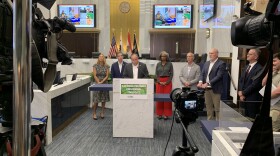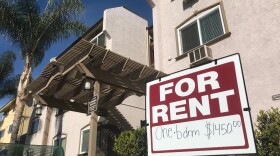Take a detailed look at one of the largest contributors to the city's landfill: construction and demolition waste. The stuff leftover from your kitchen remodel, to the tons of stuff that's generated every time a building is torn down and another constructed. We begin with a trip to the dump.
Keep your eye on the EDCO truck. There's dry wall and wood, the stuff leftover from a construction site. About a third of everything in this landfill is construction and demolition waste. We're not trying to pick on EDCO. In fact, it's known in the state as being one of the most responsible disposal and recycling companies.
It's so progressive when it comes to recycling, it opened this multi-million dollar sorting plant earlier this year.
Here, contractors and hauling companies can bring mixed loads of concrete, dry wall, metal, just about any building material you can think of. This state of the art EDCO plant will sort it, and then recycle nearly 90 percent of this material. So, why is EDCO dumping all this here, instead of bringing it here?
Steve South is president of EDCO. He gets excited when he talks about what this new plant is able to do.
Steve South : In total, probably out of this load we're able to recover about 95 per cent.It's pretty significant.
Too bad, no one in San Diego, not even EDCO, can afford to use this place. The plant can sort up to 1,000 tons of waste a day. Now, it's only going getting about 100 tons a day.
South : Every truck and every ton that comes into the facility is subject to an additional surcharge, thus taxing recycling. Including EDCO. No. Our own trucks are going to Miramar landfill because we can't afford to send them to our own facility and pay the taxes as well.
It costs $43 a ton to dump this kind of waste at Miramar. Last year, about 300,000 tons of construction waste was buried here. To bring it EDCO plant, you’ll pay $65 a ton. For large construction jobs and companies who make a living doing nothing but hauling waste, a $20 difference could be a significant portion of their profit margin.
(Graphic):
- Franchise fee = $12
- Recycling fee = $7
- Total = $19 fees for waste headed for recycling plant
Now, here's where the story gets more interesting. The reason it costs so much more to recycle construction waste rather than bury it at the landfill is because the city of San Diego charges tax on the loads headed for the recycling plant.
First there's a licensing fee called a franchise fee, $12 a ton. Private companies that haul waste from businesses, and apartment complexes pay that fee for the right to pick up trash -- an essential service. That money goes into the city's beleaguered general fund and pays for roads and other infrastructure. The city also charges another $7 a ton -- a recycling fee. It pays for recycling programs like the big blue bin in front of your house.
Gary Petersen, California Integrated Waste Management Board: This is a disincentive for recycling that is mind-boggling to me.
Petersen is on the State Board that oversees recycling efforts made by California cities.
Petersen : There's not a lot of time going on in the planet with what's happening with green house gas. We got to stop all the nonsense and get in the game and start doing the stuff we need to do. And if there are other fees that the cities and the counties need to pick up, go tax cigarette packs or something. Put 20 cents on them. That will help clean up the beach and give them money for their recycling programs. But not concentrating on recycling and disincentivising [sic] it is not the game plan."
In fact, many politicians, officials and recycling experts we talked to, all agree: San Diego's policy to charge more on recycled construction waste is ridiculous.
Ben Hueso, San Diego City Council: You don't want to have one of those fees have a negative environmental impact on your city and necessarily work in contrast to what you’re trying to accomplish in reducing waste at the landfill.
The city's own citizen task force on the environment recommended the extra fees be eliminated. Ric Anthony is a long-time recycling consultant and head of the task force, Citizens Advisory Committee.
Anthony : I think this is a real consensus issue. It's just government inertia that we’re not moving forward, so here’s our chance to see if we can make a democracy work. We go around the world telling everybody they got have democracies, yet we can't even get our elected officials to listen to us.
Some people you won't see in this story, Councilmember Donna Frye, the chair of the city's environmental committee. She declined our request for an interview, but did put this issue on the agenda of the next committee meeting.
You also won't see Mayor Jerry Sanders. We requested an interview with the mayor several times. His office declined. Eventually, the mayor's office agreed to let us talk to Elmer Heap, director of the city's Environmental Department.
Heap : When you divert material it’s a beautiful thing because you’re recycling, you’re doing the right thing, but at the same token, you're impacting financially a system we have in place. A system that was created many years ago.
Heap says it would be great if the city lowered fees and provided an incentive to recycle construction waste, rather than bury it at Miramar. But it’s a matter of money. The city would lose too much. It’s difficult to know the exact financial impact, but here are some numbers. Numbers that assume all construction waste is recycled.
The city collects $10 million in franchise fees. If one third is construction waste -- waste that was recycled rather than dumped -- that might be a loss of about $3 million.
It collects another $11.5 million in recycling fees. Again, subtract about one third, there's a loss of almost $4 million.
And finally, Miramar landfill collected $31 million in dumping fees last year. Do the math, and there are millions of dollars at stake.
Heap: The problem is this, if you divert material from being deposited at the landfill, then you’re going to impact adversely the disposal fund.
About a year from now this area will be full of garbage. In fact, it will be filed about 20 feet above my head. Once that happens, the garbage will then be dumped over in that area and that's the final cell of this landfill. That's expected to fill up in the year 2012. And once that happens, this landfill will be at capacity."
Whitney Dorn, DPR Construction: There's a statistic out there that for every square foot of construction built, there something like three to five pounds of waste that goes to the landfill, and a lot of that waste could be recycled elsewhere.
DPR is a California contractor. It's finishing the interiors of these four buildings in Carmel Valley. And its goal is to divert 75 percent of its waste to recycling plants. Even though it’s going to cost more. DPR is an exception in the construction business. And its client -- a computer software company that will move into these buildings -- is willing to pay more per square foot to be classified as an environmentally-friendly building.
Dorn : If we were able to see across the board every project making an effort to divert a percentage of waste, I think you would see prices go down drastically on what it takes to divert that waste because you would have waste streams that could count on the material coming in and it just would get more efficient. There’s just so many opportunities to reuse this stuff. We'd probably see new products being made out of construction waste because it was so available.
Several cities in the state and even the county have regulations that require construction companies to recycle at least half of its waste. The county of San Diego just passed theirs last month.
San Diego has its own ordinance requiring half of all construction waste be recycled. That regulation has been on the books for two years. So why is it not enforced?
South : The city of San Diego has such an ordinance but it’s triggered once there’s a facility in the city. This facility is approximately 40 feet outside the city of San Diego.
That's right. The city's ordinance only takes effect once a plant like this is built within the city limits, but this plant is across the street from the city limits, in Lemon Grove.
Elmer Heap says the mayor is considering whether the city should make an exception for the EDCO plant and trigger the ordinance. But remember there is a fourth R in recycling, and it stands for revenue. Revenue, according to Heap, the city of San Diego cannot live without. And so far it has no plans to eliminate the extra tax to recycle construction and demolition waste.
Heap : When you make that argument everyone just needs to appreciate the impact that has on the other side -- the impact that has on the general fund if we do that. Does it make sense if we do that? You can make a strong argument it makes sense, absolutely, and you’re making that argument and you’re making it very well. But you impact the franchise fund or the money that’s collected in franchise fees and deposited in the general fund. You impact our recycling fund.
Elmer Heap says doing the right thing, recycling, costs money. And given the city of San Diego 's sorry financial state, he wonders whether taxpayers are willing to pay the price. It may be a question the city -- a city with an annual budget of two-and-a-half billion dollars -- wants to ask of its citizens.
Heap : You're right in making the argument in saying you know what, that just seems to be such a small price to be paid for the benefit derived there from, and what can I say, and that's a very good argument.
The city is now in the process of getting approval to pile garbage higher. And, it’s in negotiations with the Navy, which owns the land in the area, to expand the landfill.





